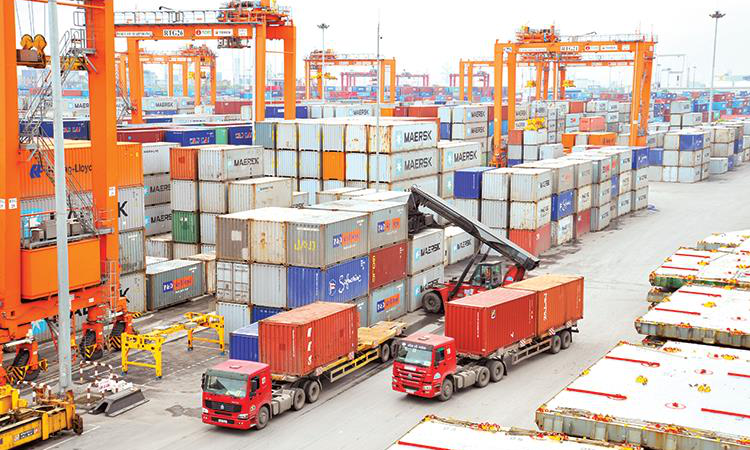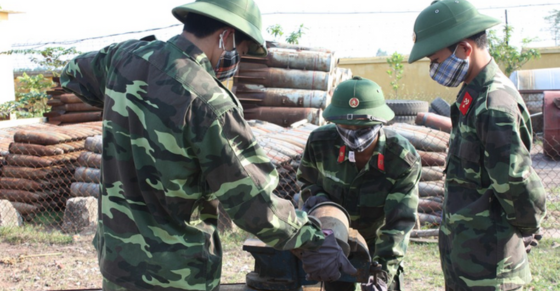Customs procedures, customs supervision and inspection procedures for in-transit cargos in Vietnam
What are the customs procedures, customs supervision and inspection procedures for in-transit cargos in Vietnam? - My Ngoc (Nam Dinh)
Pursuant to Clause 19, Article 1 of Decree 59/2018/ND-CP, the customs procedures for in-transit cargos shall be carried out at the customs office located at the first port of entry and the last port of exit, except some cases where the in-transit cargos are packed in one container or in carriages where imported and exported cargos are packed together with imported and exported cargos transported through postal or express delivery services as prescribed.
The in-transit cargos, specified in the international multilateral agreements on the transit of cargos to which Vietnam is a signatory, shall follow the special regulations of the Government's laws.
Customs documents for in-transit cargos in Vietnam
- A transportation declaration or documents that replace the aforesaid declaration written in the form promulgated by the Ministry of Finance.
- A manifest of in-transit cargos written in the form promulgated by the Ministry of Finance.
- Transportation documents if in-transit cargos are conveyed by means of sea, air or rail transport; in-transit cargos which are conveyed by means of land transport and are packed together with imported cargos: 01 copy.
- Transit permit according to the regulations of law; written announcement of the specialized inspection according to the regulations of the relevant law: 01 original.

Customs procedures, customs supervision and inspection procedures for in-transit cargos in Vietnam (Internet image)
Responsibilities of the customs declarant in Vietnam
- Carry out the customs procedures in accordance with the regulations in Clause 4, Article 25 of Decree 59/2018/ND-CP.
- Ship cargos along the routes, to the ports and within the period which is stipulated in Clause 1, Clause 2, Article 65 of the Law on Customs.
- Keep cargos intact during transportation and ensure that the cargos are protected by customs seal and the seal of transportation companies.
- In case where the in-transit cargos go through the process of transloading, warehousing, deconsolidation, changing of transportation models or means of transport, or packing in one container, the customs declarant shall require the Customs sub-department to carry out the aforesaid process. Submit 01 original of application document using the form in Appendix to Decree 59/2018/ND-CP. In case the application is approved, the customs declarant shall provide information on each transportation declaration or transportation document regarding each trip of transport.
- Show cargos for physical verification as required by the customs authority.
Responsibilities of the Customs sub-department operating at the port of entry
- Receive and handle the customs documents stipulated above.
- Carry out customs sealing for transports used for conveying in-transit cargos if the cargos are transported by road.
- As for the cargos shipped by sea, inland waterway, air, or rail transport, the customs sub-department shall carry out customs sealing if the seal of the transportation company is no longer intact.
In case where the customs sub-department can't check the seal of the transportation company for cargos shipped to Vietnam by inland waterway transport and can’t carry out customs sealing, the customs declarant shall take full responsibility for keeping the cargos intact.
- As for the in-transit cargos shipped by land or inland waterway transport, aside from implementing the regulations above, the customs sub-department shall carry out customs supervision by using means of technical equipment as prescribed.
- Assign customs officers to carry out direct supervision for in-transit cargos which are weapons, bullets, explosive materials and highly dangerous commodities shall be supervised by means of technical equipment or supervised directly by customs officers.
- Carry out physical verification for cargos of declarant who violates the customs regulations.
Responsibilities of the Customs sub-department within the territory where cargos are undergo the process of transloading, warehousing, deconsolidation, changing of transportation models, deconsolidation, changing of means of transport and packing together in one container
- Receive the application document stipulated in point d, Clause 3 of this Article and examine the conditions stipulated in Clause 9 of this Article. In case where the application does not meet the requirements, the Customs sub-department shall make an announcement of the reasons for rejecting it and provide explanation in writing.
In case where the application meets the stipulated requirements, the customs sub-department shall approve the application, return 01 original to the declarant and keep 01 copy.
- Check whether the customs seals and the transportation company seals are broken or not.
- Supervise the process of transloading, warehousing, deconsolidation, changing of transportation models, changing of means of transport, packing together in one container and carrying out customs sealing.
- Carry out customs procedures for cargos transported in different manners.
Responsibilities of the Customs sub-department at the port of exit in Vietnam
- Verify the information provided in the transportation declaration or in the documents that replace the aforesaid declaration available on the customs electronic data processing system.
- Examine whether the seals are broken or not, or whether the cargos are intact or not.
In case where the in-transit cargos are shipped by inland waterway transport to foreign countries, the Customs sub-department at the port of exit shall rely on the information provided in the declaration about the route, transportation duration and warnings (if any) to make a decision on inspection of the customs seals or the seals of the transportation company.
- Carry out physical verification for cargos of declarant who violates the customs regulations.
Customs Supervision:
- In-transit cargos shall have customs or transportation company seals. In case where the cargos can’t be sealed, the customs declarant shall take full responsibility for keeping the cargos intact.
As for the in-transit cargos shipped by inland waterway and land transport, aside from having customs or transportation company seals, they also fall into the case where they can't be sealed, the customs authority therefore will use other means of technical equipment to supervise the process of transporting the aforesaid cargos based on the result of risk analysis and evaluation.
- In-transit cargos on the list of Commodities subject to a ban on trading, export, or a temporary cessation of export, or a ban on import or a temporary cessation of import; cargos on the list of exports or imports under permits, cargos on which special tax is imposed shall be supervised by using means of technical equipment.
- In-transit cargos which are weapons, bullets, explosive materials and highly dangerous commodities shall be supervised by means of technical equipment or supervised directly by customs officers.
Some other related regulations in Vietnam
- In case force majeure is likely to damage the intactness of shipments, customs sealing, sealing by transportation company, or causes cargo fail to be shipped along the predetermined route or on schedule, customs declarants, after applying necessary measures to control and mitigate any possible loss or damage, must promptly inform customs authorities to seek any solution; in case it is impossible to give such notification, the nearest police authority, border guard or coastguard must be informed to give their confirmation or find any solution in accordance with the laws.
- The following transit activities shall be carried out at the ports of entry, ports of exit, bonded warehouses, container freight stations (CFS), venues for completing customs procedures at the inland ports of entry or exit (depot), inspection and supervision areas for cargos shipped through postal service or express delivery services: transshipment, warehousing, changing in transportation models, changing in means of transport; deconsolidation, packing together in one container, carriages carrying in-transit and to be imported cargos, or exported cargos for which customs procedures have been completed, in-transit cargos waiting to be exported, or in-transit cargos packed together with cargos which are exported and imported through postal service or express delivery services. <0
Locations of bonded warehouses, container freight stations, depot, venues for completing customs inspection and supervision for cargos shipped through postal service or express delivery services stipulated in this clause, shall conform to the in-transit routes stipulated by the Ministry of Transport.
- In-transit cargos packed together in one container, or in carriages carrying exported cargos for which customs procedures have been completed, to be imported cargos, in-transit cargos packed together with cargos exported and imported through postal service or express delivery services, shall satisfy the following requirements:
+ Each commodity shall be packed separately (packages, containers, packing, etc) in order to classify the in-transit cargos that are packed together with exported or imported cargos.
+ In-transit commodities shall belong to the cases where they do not need a transit permit as required by the laws or shall not be wine, beer or cigarettes.
+ To be imported cargos which are packed into one container, in-transit cargos carried in carriages and deconsolidated at the venues (except port of entry) as prescribed do not appear on the list of imported cargos required to follow customs procedures at the port of entry.
+ Exported cargos which are packed together in one container, cargos and in-transit cargos carried in carriages, exported cargos shipped through postal service or express delivery services and packed together with in-transit cargos shall together go through the same port of exit; the aforesaid port of exit shall be international port of exit according to the current regulations
+ Containers, carriages and equipment used for containing cargos that are shipped through postal service or express delivery services shall satisfy the customs sealing requirements.
Mai Thanh Loi
- Key word:
- Customs procedures
- in Vietnam
- Cases of land rent exemption and reduction under the latest regulations in Vietnam
- Economic infrastructure and social infrastructure system in Thu Duc City, Ho Chi Minh City
- Regulations on ordination with foreign elements in religious organizations in Vietnam
- Increase land compensation prices in Vietnam from January 1, 2026
- Determination of land compensation levels for damage during land requisition process in Vietnam
- Who is permitted to purchase social housing according to latest regulations in Vietnam?
-

- Emergency response and search and rescue organizations ...
- 10:29, 11/09/2024
-

- Handling of the acceptance results of ministerial ...
- 09:30, 11/09/2024
-

- Guidance on unexploded ordnance investigation ...
- 18:30, 09/09/2024
-

- Sources of the National database on construction ...
- 16:37, 09/09/2024
-

- General regulations on the implementation of administrative ...
- 11:30, 09/09/2024
-

- Notable new policies of Vietnam effective as of ...
- 16:26, 11/04/2025
-
.Medium.png)
- Notable documents of Vietnam in the previous week ...
- 16:21, 11/04/2025
-
.Medium.png)
- Notable documents of Vietnam in the previous week ...
- 16:11, 02/04/2025
-
.Medium.png)
- Notable new policies of Vietnam to be effective ...
- 16:04, 02/04/2025
-
.Medium.png)
- Notable new policies of Vietnam effective from ...
- 14:51, 21/03/2025
 Article table of contents
Article table of contents
